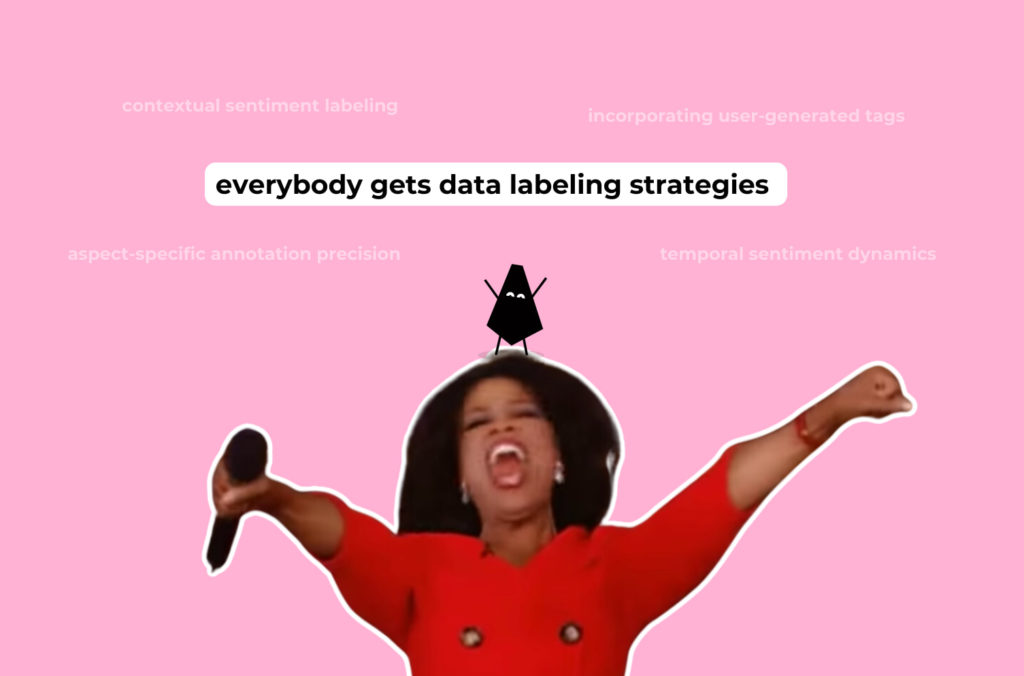Challenges and solutions in aspect-based sentiment analysis

As the architects behind Trevise, a sentiment analysis tool, we have confronted challenges in aspect-based sentiment analysis that act as catalysts for refining the entire analytical process.
Our recent conversation on the importance of context in data preparation laid the foundation for this journey. And we’ll navigate through language nuances, grapple with the complexities of machine learning, and delve into the intricacies of data labeling.
But why does this matter? Sentiment analysis isn’t just about understanding feelings; it’s a key player in deciphering the pulse of user feedback, guiding businesses toward informed decisions. In essence, it’s the compass that helps organizations steer through the sea of opinions and preferences.
Yet, our purpose here is not just to dwell on challenges. We’re also eager to unveil solutions. From harnessing advanced sentiment analysis techniques to fine-tuning machine learning models and implementing sophisticated data labeling strategies, we’re on a mission to make sense of sentiment in a way that’s both insightful and practical. So, join us on this venture, where challenges spark innovation, and solutions pave the way to a refined landscape of aspect-based sentiment analysis.

Unraveling sentiment analysis challenges
So, here we are, embarking on the intricacies of aspect-based sentiment analysis, encountering challenges that mold our comprehension of sentiments. As we’ve highlighted earlier, these challenges aren’t roadblocks; they’re chances to fine-tune our approach, leaving a lasting impact on the essence of sentiment analysis. In this section, we dive into these intricacies, striving to decode emotions with precision and construct robust models.
What to do with contextual ambiguity and sensitivity?
Understanding sentiments gets tricky with language nuances and contextual variations. To grasp the true sentiment, we must consider the broader context. Just one word can completely change sentiment when paired with negations or modifiers. Recognizing these nuances is crucial for precise sentiment classification and accurate analysis.
What about sentiment polarity?
In aspect-based sentiment analysis, sentiment polarity goes beyond a simple positive or negative classification. It involves capturing nuanced sentiments and untangling mixed expressions within a single text, reflecting the complexity of human expression.
High-quality data facilitates accurate and effective training of AI models, creating robust models that generalize well to new, unseen data. In contrast, low-quality data may lead to models learning from inaccuracies or noise, resulting in less reliable and less accurate models.
How to address challenges of applying machine learning in sentiment analysis?
Applying machine learning to sentiment analysis introduces its own set of challenges:
- Data Variability: Training machine learning models demands diverse and representative datasets, a pursuit that proves challenging in aspect-based sentiment analysis. Ensuring that models encounter a wide range of sentiments and contexts is essential for robust performance.
- Model Generalization: Striking a balance between training models on specific aspects and enabling them to generalize to new, unseen data is an ongoing challenge. Achieving this balance ensures that models remain adaptable across different scenarios.
How to label data for sentiment analysis?
Accurate labeling of data is crucial for effective sentiment analysis, but it’s not without its challenges:
- Subjectivity and Bias: Labeling data involves personal judgment, and sometimes bias. We must set clear rules and deal with bias for reliable labeled datasets, enhancing the interpretability of sentiment labels.
- Aspect-Specific Labeling: Aspects vary across different areas, making the accurate alignment of labeled data with specific aspects a meticulous yet crucial task for successful sentiment analysis. Precision in labeling ensures that sentiment analysis is focused on the relevant aspects.
Solutions to aspect-based sentiment analysis challenges
So, challenges. Challenges everywhere. But what about solutions? Likely for us, aspect-based sentiment analysis, with its intricate demands, has not only faced the challenges mentioned above but has crafted practical and effective responses. And here, we’d like to explore those tangible approaches that enhance our comprehension of sentiments and refine the precision of sentiment analysis models.
Leveraging advanced sentiment analysis techniques
Contextual embeddings play a crucial role in decoding nuanced sentiments. By considering the broader context of words, these embeddings help models mitigate the impact of contextual variations. For instance, in the sentence “The camera is excellent, but the battery life is disappointing,” contextual embeddings aid in associating “excellent” with the camera and “disappointing” with the battery, providing a nuanced understanding of sentiments within the sentence.
Semantic role labeling is another valuable technique that assists in identifying relationships between words. In the sentence “The user found the interface easy to navigate,” semantic role labeling helps discern that “user” is the one navigating, offering important context for sentiment analysis.
Fine-tuning machine learning models for precision
Fine-tune models strategically by incorporating transfer learning. This involves leveraging pre-trained knowledge and adapting it to specific aspects. For example, a model pre-trained on general sentiments can be fine-tuned to discern sentiments related to specific product features, such as “camera” or “battery life.”
Meticulous hyperparameter tuning is essential. Adjusting learning rates and regularization enhances the model’s capacity to generalize across diverse sentiments and aspects, thereby improving overall performance.
Crafting enhanced data labeling strategies
In addressing the challenges of aspect-based sentiment analysis, the development of refined data labeling strategies stands out as a pivotal solution. The accuracy of sentiment annotation and the relevance of labeled data are crucial factors in enhancing the performance of sentiment analysis models. Here, we delve into nuanced approaches that go beyond conventional data labeling methods.

Aspect-specific annotation precision
Elevate data labeling precision by focusing on aspect-specific sentiments. Rather than applying a blanket sentiment label to an entire review, narrow down annotations to specific aspects like “performance,” “design,” or “customer service.” This fine-grained labeling ensures that sentiments are accurately associated with the relevant aspects, providing a more granular understanding for model training.
Example: In a product review, pinpoint sentiments related to the “camera” or “battery life” separately, offering distinct insights into the user’s experience with each aspect.
Contextual sentiment labeling
Consider the context in which sentiments are expressed. Introduce contextual sentiment labeling to capture the nuances of sentiments within varying contexts. A sentiment expressed in one context may differ when considered in another. This approach enriches the dataset with context-aware sentiment labels, contributing to a more nuanced sentiment analysis model.
Example: Understand how sentiments change based on the user’s context, such as when reviewing a product’s performance in different usage scenarios.
Temporal sentiment dynamics
Acknowledge the temporal dynamics of sentiments by incorporating time-based annotations. Sentiments toward specific aspects may evolve over time, influenced by product updates, user experiences, or external factors. Temporal annotations provide a temporal context, enabling the model to adapt to changing sentiments and improving its predictive capabilities.
Example: Track how sentiments towards the “user interface” of a software product evolve over multiple releases, providing insights into the effectiveness of updates.
Incorporating user-generated tags
Leverage user-generated tags to enhance data labeling diversity. Allow users to contribute tags that represent their perceived aspects and sentiments. This approach introduces a user-centric dimension to the labeling process, incorporating the diverse perspectives of users into the training dataset.
Example: Enable users to tag aspects like “affordability” or “innovation,” reflecting their unique priorities in sentiment expression.
Emerging technologies and methodologies in sentiment analysis
As the field of sentiment analysis continues to evolve, innovative technologies and methodologies are shaping the landscape, offering new perspectives and enhancing the capabilities of sentiment analysis models. In this section, we explore some of the emerging trends that are influencing the future of sentiment analysis.
Deep learning architectures
The advent of deep learning has significantly impacted sentiment analysis. Deep learning architectures, such as recurrent neural networks (RNNs) and transformer models, have demonstrated remarkable abilities in capturing intricate patterns and dependencies within textual data. These architectures excel in understanding context and relationships, contributing to more accurate sentiment predictions.
Example: Transformers, with their attention mechanisms, excel in capturing long-range dependencies in reviews, enabling a more holistic understanding of sentiments expressed across the entire text.
Multimodal sentiment analysis
The integration of multiple modalities, such as text, images, and audio, is gaining prominence in sentiment analysis. Multimodal sentiment analysis allows models to leverage not only textual cues but also visual and auditory signals. This approach provides a more comprehensive understanding of sentiments, especially in contexts where emotions are conveyed through multiple channels.
Example: Analyzing both the text and facial expressions in a product review video to capture a user’s sentiment more accurately.
Transfer learning and pre-trained models
Transfer learning, particularly through pre-trained language models like BERT (Bidirectional Encoder Representations from Transformers), has become a cornerstone in sentiment analysis. These models, pre-trained on vast amounts of general language data, can be fine-tuned for specific sentiment analysis tasks, offering a head start in understanding context and nuances.
Example: Fine-tuning a pre-trained model on product reviews to adapt it to the domain-specific aspects of sentiment analysis.
Explainable AI in sentiment analysis
As the importance of transparency and interpretability grows, explainable AI techniques are finding their way into sentiment analysis models. Ensuring that models can provide clear explanations for their predictions enhances trust and facilitates the understanding of how sentiments are derived.
Example: Visualizing attention weights in a model to highlight which parts of a text influenced the sentiment prediction.
Emotion detection and fine-grained sentiment analysis
Beyond binary sentiment classification, there is a growing focus on fine-grained sentiment analysis and emotion detection. Identifying specific emotions expressed in text allows for a more nuanced understanding of user sentiments, contributing to a richer analysis of user feedback.
Example: Detecting not just positive or negative sentiments but also identifying emotions like joy, frustration, or excitement in customer reviews.
And that’s it
In conclusion, our exploration of aspect-based sentiment analysis has unraveled challenges and emphasized the opportunities for refinement and innovation. As the landscape evolves, GreenM stands ready to guide you through the dynamic realm of sentiment analysis. Whether you’re navigating deep learning architectures, exploring multimodal sentiment analysis, or delving into emerging trends, contact GreenM for a partnership dedicated to your success in sentiment analysis. Your journey is our priority, and GreenM is here to ensure it’s marked by continual refinement and strategic insights.






